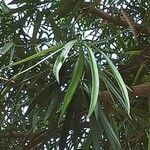Trees to 25 m tall; trunk usually to 5 cm d.b.h.; bark grayish brown, thin, fibrous, peeling off in longitudinal flakes; branches spreading or ascending. Foliage bud scales erect, triangular, 1-1.5 mm wide, apex acute. Leaf blade lanceolate, usually slightly curved, (4-)7-15(-20) × (0.5-)0.9-1.3(-2) cm, leathery, midvein raised adaxially, flat or slightly raised abaxially, base cuneate into short petiole, apex long acuminate; juvenile leaves wider, with obtuse, mucronate apex. Pollen cones solitary or in clusters of 2 or 3, normally sessile, 2.5-5 cm, with several spirally arranged, basal bracts. Seed-bearing structures axillary, solitary; peduncle 0.9-2.2 cm. Receptacle orange-red when ripe, obconical-ellipsoid, 8-10 × 5-8 mm, base with 2 subulate bracts 2-6 mm. Epimatium purplish red when ripe. Seed ovoid or ovoid-subglobose, 0.8-1.6 cm, apex rounded or obtuse. Pollination May, seed maturity Aug-Nov. 2n = 34.
An evergreen tree. It grows to 45 m tall. The trunk is 100 cm across. The crown is dome shaped. There can be buttresses 2 m high. The bark is grey-brown and scaly. It is cracked with scaly ridges. The young leaves are 15-24 cm long by 2.4 cm wide. They have a sharp tip. The base narrows to a short leaf stalk. The mature leaves are 7-12 cm long by 1-1.8 cm wide. They taper to the tip. The male cones occur singly or in groups or 2 or 3. They do not have stalks. The female cones have a bright red receptacle. The seed is oval and 7.5-10 mm long. The fruit are edible.


